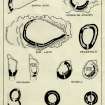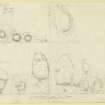Field Visit
Date 10 June 1915
Event ID 1104222
Category Recording
Type Field Visit
Permalink http://canmore.org.uk/event/1104222
Dun, Barra Head Lighthouse, Berneray.
Barra Head Lighthouse is built on the highest point in the island of Berneray, not on Barra Head proper, which is the most southerly point in the Outer Hebrides, but near the end of a small promontory, Sron an Duin, about ¾ mile to the north-west and ¼ mile east of Skate Point, the most westerly point in the island. This promontory within the grounds of the lighthouse is the site of a very interesting fort, which occupies one of the wildest and grandest positions in Scotland, the cliffs by which it is bounded on two sides rising over 600 feet from the Atlantic. A massive drystone wall, curved slightly in the centre towards the land, is built across the promontory and encloses a narrow triangular space about 45 yards long, and about 14 yards across at the centre. The interior has been hollowed out, at what period is not known, leaving a ragged parapet of rock from 6 to 10 feet high all round. On the exterior for the greater part of its length the wall stands 9 feet high, many of the blocks of which it is built being of great size, the largest measuring 7 feet long by 2 feet 9 inches high. Some 12 feet from its western end is the entrance passage which still retains its lintelled roof (Fig. 190). The entrance is 5 feet 3 inches in height and 2 feet 2 inches in breadth and the passage is paved. On the east side of the passage a facing of later construction narrows the entrance for some 5 ½ feet from the outside, when there is a return, 1 foot 10 inches deep, beyond which the original wall is continued inwards for1 foot 3 inches. On the west side the wall of the passage runs in for 3 feet 6 inches, where there is a check of about 6 inches in depth, after which it is carried inwards for 10 feet with a slight curve towards the east. The outer part of this wall on the west of the passage is also curved concavely, so that while it is about 12 feet thick between the passage and the edge of the cliff, at its southern termination, which is 7 feet 3 inches high, it is only 2 feet 7 inches thick. There is a bar-hole, 10 inches high, 9 inches broad, and 3 feet deep, 8 inches behind the check on this side. There is a cavity opposite it on the other side of the passage, but it is not carefully built. The two outer lintels of the passage cover a length of 3 feet 7 inches, and the inner lintel is placed 1 foot higher than the other two. The thickness of the main wall is not ascertainable, as the inner side is broken down and covered with debris, but it has contained two galleries, one superimposed on the other. A number of the lintels of the lower gallery, which is about 3 feet 9 inches wide, remain in position at three places, and the inner face of the outer portion of the wall stands 3 feet 6 inches above them. This outer half of the wall is 5 feet 4 inches thick. On the inside the wall measures 52 feet in length from the entrance to the edge of the cliff. See Proc. Soc. Ant. Scot., Vol. XXVII., pp. 341-6. Martin remarks of Berneray: ‘There is an old fort in this island, having a vacuity round the walls, divided in little apartments’.
RCAHMS 1928, visited 10 June 1915.
OS map: Barra lxx.



















